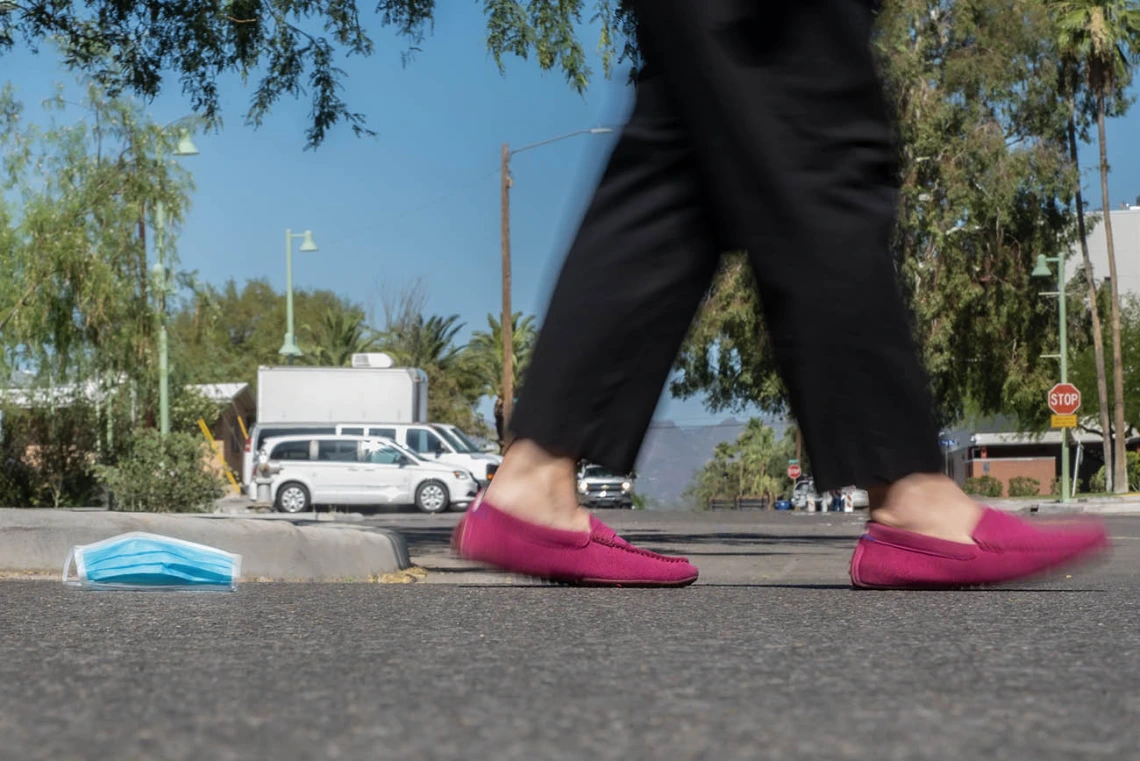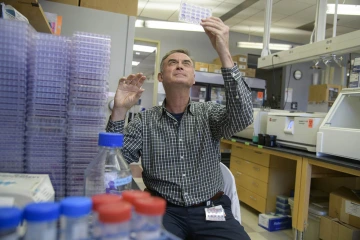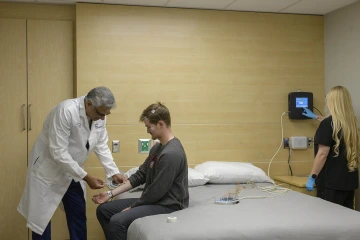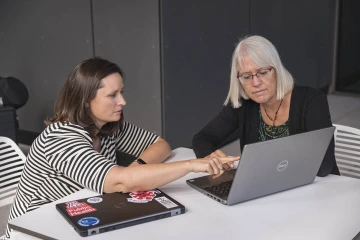Fighting the second pandemic: long COVID
Researchers are defining long COVID and exploring the underlying cause and consequences of the disease that is affecting millions of people.

COVID-19 public health emergency declarations have expired, but millions of people are suffering from a wide range on ongoing and complicated health conditions that can last weeks, months or even years.
After years of unprecedented endeavors to reduce hospitalizations and deaths, COVID-19 public health emergency declarations by the World Health Organization and the U.S. government have expired. But a second pandemic known as long COVID looms large for people suffering from a wide range of ongoing and complicated health conditions that can last weeks, months or even years.
More than 10% of people who had COVID-19 might have long COVID, according to research conducted at the University of Arizona Health Sciences. As researchers quickly work to understand the new disease, people with myriad symptoms face a number of possible frustrations when seeking care.
“There is a striking void in care for people with SARS-CoV-2 postviral syndrome, especially when compared to the national action to combat acute COVID in the beginning of the pandemic,” said Janko Nikolich, MD, PhD, director of the Aegis Consortium and head of the College of Medicine – Tucson’s Department of Immunobiology. “There are a wide range of symptoms associated with long COVID, so patients are often referred to different specialists, such as cardiologists, pulmonologists and neurologists. It can be time consuming, stressful and expensive. Even worse, some patients are still told that this is all 'in their heads' because most doctors do not know how to diagnose or treat long COVID.”
On top of the immediate issue of people needing effective treatment for long COVID, there are many unanswered questions surrounding its symptoms and the potential for unforeseen consequences years in the future.
“One of several theories about long COVID is that an acute infection leads to an activation of dormant viruses, such as the Epstein-Barr virus,” said Kristen Pogreba-Brown, PhD, MPH, associate professor and epidemiologist in the Mel and Enid Zuckerman College of Public Health. “This is concerning because a driving hypothesis for the underlying driver of multiple sclerosis is history of EBV infection. Does that mean in 10 to 20 years we will see an increase in MS patients? We simply don’t know, and more research needs to be done.”

The Researching COVID to Enhance Recovery Initiative was established to find answers to post-acute sequelae of SARS-CoV-2 infection-related issues including why some people recover while others do not, risk factors and strategies for preventing and treating PASC.
UArizona Health Sciences researchers are taking a leading role in the search for answers to the questions surrounding long COVID, including work being done through the National Institutes of Health’s Researching COVID to Enhance Recovery (RECOVER) initiative and CoVHORT, as well as several other studies.
What is long COVID?
According to the Centers for Disease Control and Prevention, each time a person is infected or reinfected with SARS-CoV-2, the virus that causes COVID-19, they are at risk of developing long COVID. Commonly reported symptoms include but are not limited to fatigue, difficulty breathing, cough, chest pain, change in smell or taste, brain fog, joint pain, and gastrointestinal issues.
Researchers are trying to better understand the reasons behind the unusually diverse and vague combination of symptoms. They say the pervasive nature of the virus is a likely culprit.
“This virus enters the endothelial cell, which lines the inside of blood vessels. Endothelial cells are everywhere in the body. Every organ in the body needs blood to function,” said Sairam Parthasarathy, MD, professor of medicine and chief of the Division of Pulmonary, Allergy, Critical Care and Sleep Medicine in the College of Medicine – Tucson’s Department of Medicine, director of the UArizona Health Sciences Center for Sleep Circadian and Neurosciences, and one of four principal investigators on the Arizona RECOVER study. “So, this virus affects every nook and cranny of the body – the ovaries, the testicles, the skin, the brain, you name it. Even our nerves have blood vessels in them.”

Janko Nikolich, MD, PhD, is leading the Arizona Post-SARS-CoV-2 Cohort Consortium (AZP3C), a six-institution partnership supported by the RECOVER Clinical Science Core at New York University Langone Health. He is the director of the Aegis Consortium which unites a diverse coalition of experts across multiple disciplines to find solutions for a pandemic-free future.
All three researchers say a clinical definition is crucial to the treatment of long COVID. Through the NIH RECOVER initiative, they were part of a nationwide study to develop a definition of post-acute sequelae of SARS-CoV-2 infection (PASC; which is the scientifically accurate name for long COVID). RECOVER seeks to understand, treat and prevent PASC.
“Our goals are to define the clinical spectrum and pathophysiology of long COVID, to determine its natural history and prevalence, and to characterize the way in which SARS-CoV-2 causes post-acute sequelae,” said Dr. Nikolich, who is the contact principal investigator for the Arizona Post-SARS-CoV-2 Cohort Consortium, a six-institution statewide partnership and one of more than 30 research teams across the country participating in the NIH’s RECOVER initiative.
In the recently published paper in the Journal of the American Medical Association, co-authored by Drs. Parthasarathy, Pogreba-Brown and Nikolich, investigators of the RECOVER study analyzed nearly 10,000 study participants who self-reported their symptoms. Researchers identified 37 symptoms present more often in SARS-CoV-2–infected participants at 6 months or more after infection compared with uninfected participants. The 12 symptoms that emerged most prominently included post-exertional malaise, fatigue, brain fog, dizziness, gastrointestinal symptoms, palpitations, change in sexual desire or capacity, loss of or change in smell or taste, chronic cough, thirst, chest pain, and abnormal movements.

Sairam Parthasarathy, MD, has a broad background in clinical-translational research with emphasis on intervention-based approaches in sleep, COVID-19 and health disparities. He is the director of the University of Arizona Health Sciences Center for Sleep, Circadian and Neuroscience Research.
“To aid clinicians, we have developed a scoring matrix with some symptoms, such as loss of smell, weighted more heavily than others,” said Dr. Parthasarathy. “If someone is six months past a COVID infection and scores 12 or higher, this would give us a clear indication they have long COVID. Patients with troubling symptoms that score below 12 would still need to be evaluated for possible long COVID, but this gives us a starting point for diagnosis and treatment.”
Catching all the data
Dr. Pogreba-Brown is a co-investigator on the RECOVER initiative and also leads AZ CoVHORT, an online research study of COVID-19 and post-COVID conditions. More than 8,800 Arizonans are enrolled in the study.
“CoVHORT is a very traditional, longitudinal epidemiologic study. We try to be as hands-off as possible, because we are trying to see what the progression of things are over time. This information will help us understand what treatments work best in the fight against long COVID,” Dr. Pogreba-Brown said. “We send people surveys every three months if they are not having symptoms or every six weeks if they are having symptoms.”
CoVHORT aims to catch all of the data to track how a COVID-19 infection might progress into long COVID for some and not others.

Kristen Pogreba-Brown, PhD, MPH, (left) says Arizona is first in the nation when it comes to COVID-19 deaths per capita. She says the CoVHORT study will be critical to addressing the rural and cultural populations that are unique to the state, looking at biomedical and social risk factors, and translating the data into practice and treatments. Pictured here with Melanie Bell, PhD, professor emeritus at the Mel and Enid Zuckerman College of Public Health.
“We want to know if you get sick, how quickly are you recovering? If you are having long-term symptoms, what are those symptoms?” she said. “We ask people questions about what their health was like before the pandemic, such as other chronic conditions they might have including diabetes or heart disease.”
Questions related to stress, anxiety and depression are also included. The study also asks about food security, multigenerational housing, health insurance and work environment. This will help elucidate social determinants that play a role in outcomes.
According to the World Health Organization, more than 658 million people worldwide have been infected with SARS-CoV-2. In the U.S., the CDC states most Americans have had COVID-19. Even if the prevalence of long COVID is only a small fraction of the total number of infections, the world’s health care systems are facing another enormous challenge.
“We believe our research efforts are a building block towards more precise and effective treatments for long COVID,” Dr. Nikolich said. “All signs point to an urgent need for more education, research and clinical support surrounding long COVID today and in the years to come.”
Thanks to UArizona Health Sciences researchers and the work they are doing through the Aegis Consortium, NIH’s RECOVER initiative and CoVHORT, the groundwork has been laid for the development of improved awareness and treatment options for long COVID.
Our Experts
Janko Nikolich, MD, PhD
Professor and Head, Department of Immunobiology, College of Medicine – Tucson
Co-Director, Arizona Center on Aging
Director, AEGIS Consortium
Professor, Medicine
Professor, Nutritional Sciences
Member, BIO5 Institute
Member, Cancer Biology Program, UArizona Cancer Center
Sairam Parthasarathy, MD
Professor, Medicine
Chief, Division of Pulmonary, Allergy, Critical Care and Sleep Medicine
Director, Center for Sleep and Circadian Sciences, UA Health Sciences
Medical Director, Center for Sleep Disorders, Banner – University Medical Center Tucson
Member, BIO5 Institute
Kristen Pogreba-Brown, PhD, MPH
Associate Professor, Mel and Enid Zuckerman College of Public Health
Member, BIO5 Institute
Contact
Brian Brennan
Health Sciences
Office of Communications
520-621-3510
brianbrennan@arizona.edu

